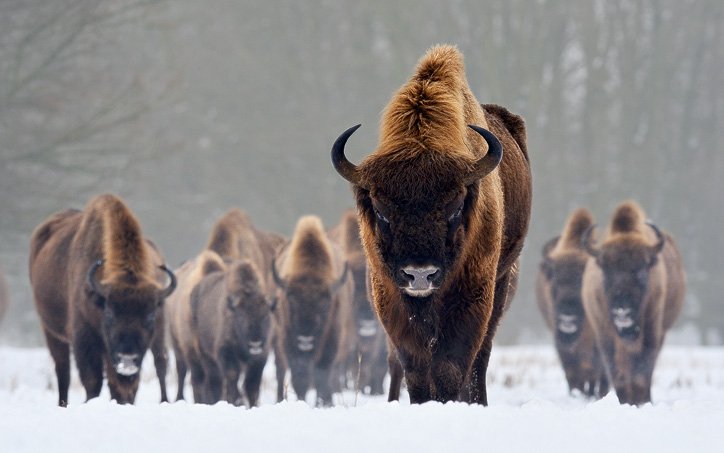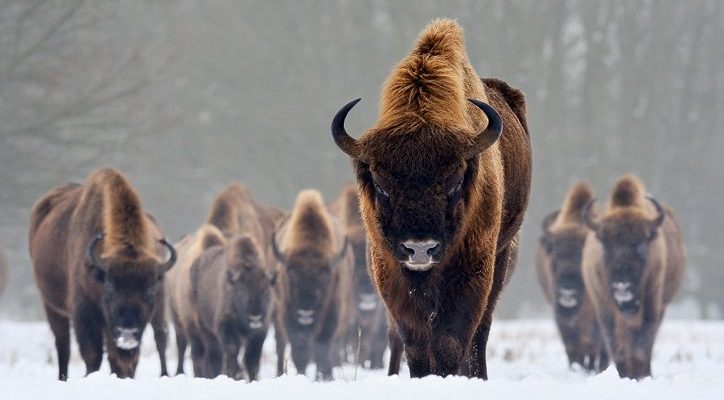
Let’s dig into how the European bison has evolved over the ages and how it has adapted to survive in changing environments. It’s like a storybook filled with trials and triumphs, where every chapter teaches us something about survival, adaptation, and the delicate balance of nature. Here’s the thing: understanding the evolutionary history of the European bison isn’t just about the past; it gives us valuable insights into conservation efforts today and highlights how interconnected wildlife and humanity truly are.
The Origins of the European Bison
The story of the European bison traces back to the Pleistocene epoch, around 2.6 million years ago. This was a period marked by ice ages and significant climatic shifts. The ancestors of today’s bison began to diverge from other bovines during this time. If you think about it, the Pleistocene was like an ancient buffet of evolutionary opportunities—some species thrived, while others vanished.
The initial ancestors of the European bison are believed to share a common lineage with both the aurochs (wild cattle) and the American bison. As the climate changed and landscapes transformed, these early bison adapted to different habitats across Europe. Imagine vast forests and open plains dotted with these magnificent beasts, each one perfectly in tune with its environment. The European bison evolved to be larger and more robust compared to their ancestors, adapting to the varying conditions of their new homes.
The Two Main Subspecies
Today, the European bison is mainly represented by two subspecies: the Lowland bison and the Highland bison. Each of these subspecies boasts unique traits that allow them to thrive in their specific environments. Let’s break it down a bit.
- Lowland bison: These bison inhabit the marshy forests and grasslands of Europe. They are typically larger and more robust, perfect for grazing in their lush habitats.
- Highland bison: Smaller than their Lowland cousins, Highland bison are adapted to the cooler, harsher mountainous environments. Their more compact build helps them navigate steep terrain and tough weather.
It’s fascinating how nature shapes species to fit the mold of their environment. The Lowland bison, for instance, thrives in open landscapes where they can easily graze, while the Highland bison has adapted to rocky conditions where foraging requires more agility. This adaptability showcases the resilience of the species and its capacity to endure through varying climates.
Extinction and Conservation
Unfortunately, the story of the European bison isn’t all sunshine and grazing pastures. By the early 20th century, centuries of hunting and habitat loss led to the near extinction of these magnificent animals. Picture the once-thriving herds diminished to just a few remaining individuals. It’s heartbreaking, isn’t it?
Luckily, conservationists recognized the urgency of the situation. Efforts began in the 1920s, focusing on breeding programs and creating protected areas. Today, thanks to these dedicated efforts, the population of European bison has gradually increased, and they can be found in several European countries, roaming freely in reserves and national parks.
Let me explain: the successful conservation of the European bison is a brilliant example of how human intervention can lead to positive change. By setting up reserves and promoting awareness, we can ensure that future generations can witness these majestic animals in their natural habitat.
The Role of European Bison in Ecosystems
You might be wondering what role the European bison plays in its ecosystem. These gentle giants are not just beautiful to behold; they also contribute significantly to their surroundings. Their grazing habits help maintain the health of grasslands and forests. By munching away at plants, they prevent overgrowth, allowing a diverse range of species to thrive.
European bison are considered keystone species. This means their presence has a disproportionately large impact on their environment compared to their population size. When they graze, they create open spaces for other plants, which in turn support a variety of wildlife. Picture a thriving meadow filled with wildflowers and other animals, all thanks to the bison’s natural behavior.
Moreover, as these bison wander through their habitats, they help to spread seeds, contributing to the growth of new plants. It’s like having a natural gardener at work, ensuring that the circle of life continues smoothly.
Challenges Facing European Bison Today
While the future of the European bison looks brighter, it still faces challenges. Habitat loss due to agriculture and urban development is a significant threat. As humans expand their land use, the space bison need to roam and graze diminishes. It’s a classic story of two species vying for the same space.
Another challenge is the risk of inbreeding due to the small gene pool of the remaining bison. This can lead to health issues and reduced adaptability to environmental changes. To combat this, conservationists are implementing strategies like creating wildlife corridors that allow for genetic exchange among populations. After all, a diverse genetic background is essential for a species’ survival.
The Future of the European Bison
As we look to the future, the European bison can serve as a symbol of hope and resilience. Conservation efforts continue to grow, with more protected areas being established and awareness campaigns reaching wider audiences. There’s a collective effort not only to save the bison but to restore the ecosystems they inhabit.
Efforts are also being made to educate the public about the importance of biodiversity and conservation. By involving local communities in these efforts, we can create a sustainable future for these magnificent creatures. It’s all about nurturing our connection to the natural world and understanding that we play a part in its story.
The evolutionary history of the European bison is a tale of resilience, adaptation, and survival against the odds. From their ancestors roaming ancient landscapes to their near extinction and remarkable recovery, these creatures continue to teach us valuable lessons about conservation and coexistence.
So, the next time you think of the European bison, remember—they’re not just animals; they’re a living testament to the beauty and complexity of life on this planet. As we work together to protect them, we also safeguard the ecosystems they inhabit, ensuring that future generations can experience the wonder of these incredible animals.

